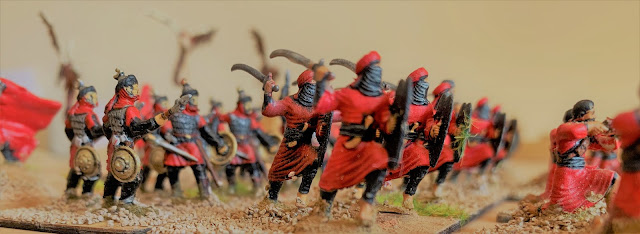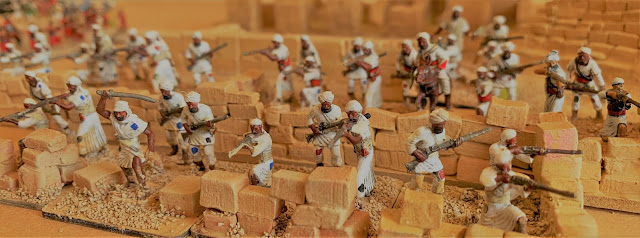
Thought I'd get this scenario up after posting the previous
No Relief from the Midday Sun scenario.
This scenario has been played twice with close games standing at a one all victory for Brits and Ansar. Seems to be well balanced, with
game one (battle report) and
game two (battle report) both sea-sawing between victory for each side.
An A4 PDF of the scenario
can be found here.
Hashin, Northern Sudan, March 1885
On the 21st March 1885, most elements of General Graham's Suakim brigade saw action at Hashin.
While the East Surrey Regiment and Royal Engineers set up communications and a fortified position a few miles to the east of Hashin, in the west, Ansar were sighted around a hill called the Dihilbat feature, and Graham sent his Indian Brigade, several regiments of foot, and elements of cavalry, forward to drive the Ansar from the feature - supported by the Guards Brigade.
Several smaller assaults and engagements followed but fearing envelopment by flanking Ansar from Tamai, and due to an over extension of division forces across several miles, before the Ansar made a more determined assault, the action resulted in Graham withdrawing his forces and subsequent battle at Tofrik the next day.
This scenario explores the 'what if' possibility that the Ansar mounted their attack at Hashin rather than Tofrek, before Graham had a chance to withdraw.
Area Around Hashin
The area around Hashin was open, yet covered with scrub and mimosa (6-8 feet high in some places).
The major features of the Hashin area were the Dihilbat spur or hill, and Beehive hill next to it, where Hashin was actually nestled - which can be represented by several small huts against the north-west of Beehive Hill.
Further to the north-west was another feature of broken ground called the Low spurs of the Waratab.
Tamai lay some miles to the south-west and was then a centre for Ansar troops.
There is an excellent map of this area on page 147 and description of the action in
Lt. Col Snook's Go Strong into the Desert, published by Perry Miniatures.
Graham's division ended up spread over several miles, from Hashin and back east across open ground to the minor features where the Surreys and engineers were creating their redoubts.
Set Up
On the day, there were several sightings and interactions with the Ansar between 0940 and 1225, but no concerted major attack.
This scenario considers the situation where the Ansar, at some point between those times, made a coordinated and major assault of Graham's forward (western) elements, with original dispositions of those elements used as starting positions.
This makes the Dihilbat feature, Beehive Hill, and Low spurs of the Waratab the key features for the the scenario table.
So far we've used 280cm x 150cm and 300cm x 240cm tables to good effect for this scenario. I'm not sure what this is in Imperial measure, probably a few cubits and Google can do the conversions for you... or alternatively it may be easier to move to a country that employs modern measurements... :)
As we know the lay of the land, on the British side of the table, set up should include Beehive Hill (hill feature) and Dihilbat Hill (large hill feature). These should be set up on the table edge in the centre, with just enough room between the features to house a British square.
If you are fortunate to have enough terrain, the Dihilbat feature should stretch almost across the board and be set up on the British player's left.

The Low spurs of the Waratab should cover a good portion of the Ansar player's left quarter and represent uneven, undulating even, semi-broken ground, and stretch up to the centre of the table.

The rest of the ground was fairly open but much of it covered in scrub and Mimosa, so if you have these terrain pieces, a good portion of the open ground can be covered in scrub - providing further cover for the Ansar.
Also we employ a house rule called Sudanese Rough Ground.
Most features are rocky or covered in scrub. Given the superb tactical use by the Ansar and effect on British cavalry (they get mauled when fighting in it),
Sudanese Rough Ground is as follows: as per Rough Ground, plus Unclear targets, Ansar infantry get Cover, -2 morale saves to cavalry fighting H2H in it.
So there should be a good mix of Rough Ground and Sudanese Rough Ground on the table.
Measurements are for 20-28mm standard basing and Brigade Square rules are used, with even partial brigade squares claiming supports from other units in the square. All Cav units are Marauders.
Unless otherwise specified, units are assumed as listed in
Blood on the Nile supplement.
Forces
Commanders
Each side gets two commanders, including the army general.
British Forces
Indian Brigade: The 5th Ludhiana Sikhs, 17th Bengal Native Infantry, and 28th Bombay Native Infantry (3x Standard BP formations), 9th Bengal Lancers (Standard BP formation), a Naval Brigade Gardner and Tiny support formation, and 2 screw guns (or one medium artillery piece).
2nd Brigade: The Berkshire Regiment and Royal Marine Light Infantry (2x Standard BP formations), squadron of 9th Bengal lancers (Small BP formation).
Reinforcements: 1st Battalion Coldstream Guards, 3rd Battalion Scots Guards (2x Standard 'guards' BP formation, starting off table, available from turn three onward, and assigned to a brigade as the general sees fit).
Ansar Forces
Green Flag Rub: 6 x Hadendowa (Standard BP spear/sword formations)
Black Flag Rub: 3 x spearmen/swordsmen (Standard BP formations), 2 x African Riflemen (Standard BP formations), 3 x Small rifle-armed skirmishers.
For some reason this scenario suits a ratio close to 1:1 British:Ansar rather than 1:1.5. I think this is because the terrain favours the Ansar and the African (slave) Riflemen are given a shooting quality of 3 (as per the indications of their projected firepower in
Michael Asher's history of the Sudan conflict called 'Khartoum').
Its worked twice so far, but if it seems weighted in the Brits favour, chuck a couple more spearmen units into the mix for good measure, and stir thoroughly. Or vice versa.
Force Notes
- Ansar Spearmen and Riflemen are Warband, Spearmen are fanatics.
- Ansar Riflemen have a shooting quality of 3 and H2H of 4.
- Ansar Riflemen and Skirmishers are armed with Breech-loading Rifles.
- All British forces are Steady.
- Guards are Elite 4+.
- Bengal lancers are Marauders but do not count Lance. They were only given lances two weeks before this action so are treated as 'lance-armed' Medium Cavalry.
- The Naval Gardener gun is considered Accompanied, in that the Tiny Naval Brigade unit is 'attached' to the gun. So if at least two of the Naval Brigade figures are touching the gun, it can move as Infantry.
Dispositions
Along with the lay of the land, we are fairly certain of the dispositions of the British on the day. As such, at the start of the game:
- the two screw guns are placed on Beehive Hill
- the 5th, 17th, 28th, along with the Gardener are placed in a partial brigade square in between Beehive Hill and the Dihilbat feature
- the Berkshire Regiment and Royal Marine Light Infantry are placed on the Dihilbat feature near the table edge
- the Bengal lancer units are placed anywhere within 30cms (12 inches) of the British player's table edge.
- reinforcements arrive at the beginning of the British player's turn three and units can be assigned to either or both brigades as the player sees fit, placed on the table edge nearest the brigade the unit will join.
See photo map above for indications of British dispositions at the beginning of the game.
For the Ansar, we know where they were around 0940, massing around the Low spurs of the Waratab and several masses of Ansar were south of the Dihilbat feature and on the feature itself. We also know that Tamai was not that far away to the South-west. As such:
- Ansar enter the game in the first round, from either corner of the Ansar player's table edge and
- One Riflemen unit and Skirmish unit is placed on or to the left and touching the Dihilbat feature, at the centre of the board.
Victory
Gentlemen and woman will either concede or not force their opponents to continue, perhaps before one brigade is entirely broken and the other is mostly shattered.
I hope you enjoy the scenario as much as we have.












































































